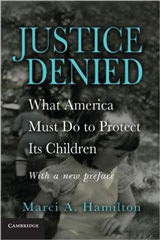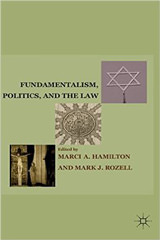Child sex abuse is one leg of the three-legged stool of the #MeToo movement: harassment, sex assault, and child sex abuse. It was also the first domino to fall in the historic shift toward holding those guilty of sexual misconduct to account. Indeed, it was a 13-year-old girl telling Tarana Burke about her sex abuse that led to Tarana’s now iconic coining of the phrase “Me Too,” which eventually turned into #MeToo. It has been stunning to see how quickly the #MeToo phrase was embraced to cover sexual misconduct against adults, and the pace of disclosure has been awe-inspiring. From the October revelations about Harvey Weinstein to today, in only a few months, we have seen disclosures from every corner where women (and some men) could be subjugated: Hollywood, universities, corporations, sports, politicians, television, radio, music, and restaurants—to name only a few. The fast-moving waterfall of disclosures has yielded an ocean of information, and the response has been swift, with Hollywood actresses quickly creating a harassment legal fund with over $13 million to help the victims of harassment.
Mere disclosures are certainly not enough to make permanent change, as I discuss here, but this remarkable action plan shows what can happen in very short order.
Comparatively, the movement to end child sex abuse has been more of a game of slow-motion dominos. Always a crime, it has been more difficult for the victims to get traction because they were children, and children are powerless, particularly when their interests are at odds with adults and institutions. Child sex abuse has been hidden from public view forever. In 2002, the ugly institutional facts about the Boston Archdiocese’s cover up of prolific pedophile priests spilled onto the headlines. It was not a matter of months but years for the successive environments for child sex abuse to be revealed. Over the last 15 years we learned about the Boy Scouts, Penn State football, and Syracuse basketball, more religious groups, public and boarding and private schools, just to name a few categories that have appeared.
It didn’t take long to hear the horrific stories of abuse of one child after another before it became abundantly clear that all they had was the ability to tell their stories. Disclosing their abuse for some was cathartic—though it is often fraught with anxiety and PTSD. Yet, for each child sex abuse victim—she is a crime victim and such crimes demand action against the bad people and institutions that hurt them. It was heartbreaking to hear their stories and see them so hopeful for justice—because justice was impossible for most.
The vast majority were blocked from any legal action. And most of us know why now: Because the statute of limitations (“SOLs”) for both criminal prosecution and civil claims in most states were arbitrarily blocking them from claiming any power over the abuse or their abusers. It was obvious that the best way to level the playing field was to extend or eliminate altogether the SOLs, forward and even backward. A movement was born, and the first state in the union to successfully revive expired civil claims, California, saw 1,150 victims come forward in 2003 alone. Many states have extended their civil and criminal SOLs for child sex abuse since then, and some have also revived expired SOLs. There was really a moral imperative to do so.
The history of SOL reform has been one of incremental additions over time. Only after 2002 did states like Delaware and Minnesota take the large steps forward to eliminate both civil and criminal SOLs and to revive expired civil SOLs. They still did not achieve the apex of SOL reform: Only Guam has done that—sweeping away the SOLs backwards and forward.
2017 Year in Review
The good news is that the movement did not slow down in 2017, with ten states seriously considering significant SOL reform, and seven states passing laws that improved their SOLs for child sex abuse. A 70% pass rate for legislative reform is extraordinary!
This year, a majority of the changes were either extensions of the civil SOL (KY, MD, NV, and OK) or its elimination (NE, though only against the perpetrator). The civil extensions ranged from an extension to age 28 (KY) to age 38 (MD and NV), and age 45 (OK, against the perpetrator).
What must be noted about these civil SOL changes, though, is that every single state left room for improvement. None simply eliminated the civil SOL altogether against the perpetrator and institutions, like Alaska, Connecticut, Delaware, Florida, Illinois, Maine, and Minnesota.. They are kicking the can down the road. There will be cases in the future that push them in that direction, I have no doubt.
The few changes to the criminal SOLs in 2017 occurred in Illinois, where the state eliminated the criminal SOL for all sex abuse crimes (not just the most serious ones) and in Oklahoma, which extended the criminal SOL to age 45 and eliminated it for cases with DNA evidence. In both states, change was spurred in part by disclosures about sex abuse by men in public office.
A more detailed summary of all of the changes and the state of civil and criminal SOLs in the states can be found here. If you compare the state of child sex abuse SOLs now to those in 2002 when the dominoes started to fall, there has been a lot of improvement. Yet, in some states there has been none, and they remain stuck with SOLs that positively endanger children by hiding child predators and blocking victims’ access to justice. Those states are New York, Alabama, Mississippi, Georgia, and Michigan. Alabama’s short SOLs gave fire to the critics of Roy Moore’s young victims, as they were able to self-righteously proclaim that he deserved a presumption of innocence until proven guilty. Given that none of the women who came forward had a snowball’s chance in hell to file charges or sue for damages—because of the Neanderthal SOLs in that state– that’s a mighty empty statement.
New York is the most curious of all, though, as it is a “liberal” northeastern state that is tagged with being too progressive by much of the country. Yet, the powers that be have been incapable of improving by even an iota the shockingly short SOLs. Victims need until middle age on average to come forward. For most victims in New York, they are shut out by age 23. The Catholic bishops (encouraged by their insurance carriers) were using their muscle to block the reform for over a decade, saying it was “unfair” for them to have to compensate victims in cases where the evidence is “stale” and memories are “unreliable.” But now, with the diocesan compensation programs, they are compensating hundreds victims even if they are out of statute.. And the compensation is competitive against national averages. Apparently, there is enough evidence for the old cases to justify compensation! Now, the bishops aren’t helping every victim—they are pretending they are not liable for the order priests in their jurisdictions; regardless, they have undermined their arguments against cases from the past.
Now, it’s up to the New York political leadership in both parties to sit down and just finally do the right thing. Every New York lawmaker needs to refocus and see what is right in front of them: modernizing the child sex abuse SOLs puts them on the right side of history, and blocking such change will haunt them later. For every day that they persist on doing nothing, they are responsible for the hidden child predators in New York operating at will because of the short SOLs.
I suggest they look to Pennsylvania’s Attorney General, Josh Shapiro, who is carving out a successful political career by taking a no-holds-barred approach to child sex abuse. He is the only AG currently with a pending grand jury investigating sex abuse of children in Catholic dioceses. And he’s not content with one Pennsylvania diocese—he’s investigating five. That is what successful leadership in the #MeToo era looks like.










Statutes of Limitations exist for a reason. Just think about all of those falsely accused people during the heyday of the Satanic Panics of the 1980s. Hamilton is in the minority by STILL believing in those outlandish claims of satanic pedophile illuminati cultists sacrificing kids in underground bunkers under daycare centers across America. The fact that this propagandist is influencing America to abandon constitutional safeguards is outright scary.